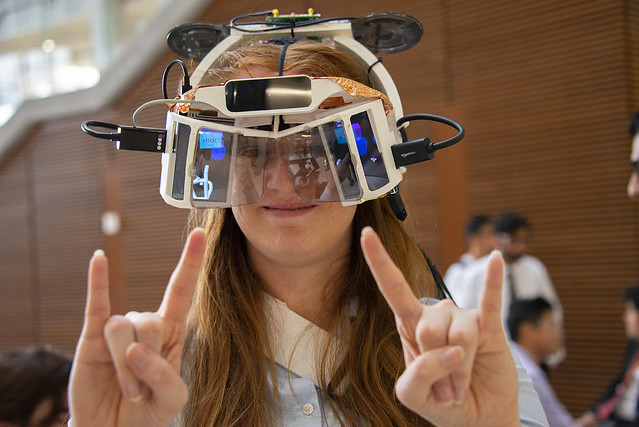Upper division undergraduate students in Texas ECE complete a required capstone design course sequence. In the courses, students solve open-ended problems submitted by industrial collaborators. Students work in small groups over two semesters to identify an opportunity, define the problem, analyze competing needs and requirements, perform prior art and patent searches, develop alternative designs, carry out cost analyses, and select and implement a design solution.
Past Project Examples
Tappy Feet
Tappy Feet is a pair of clip-on sensor packs for your shoes that allow for a more accessible and portable solution in the field of fitness wearables. Our current prototype interfaces with a web application over Bluetooth to enable the user to play a clone of Dance Dance Revolution. For this pilot application, we were able to create a highly accurate step classification model to reward players for correct form and direction based on low-latency sensor data. However, the product is more of a platform rather than a single game – developers will be able to use our technology to make similar fitness-based games so that users can enjoy a variety of fun ways to exercise anywhere.
Team: Amogh Agnihotri, Reese Costis, Melanie Feng, Caleb Kovatch, Luca Tomescu, David Yuan
Faculty Advisor: Dr. Constantine Caramanis
Wireless Sleep Monitor
The Wireless Sleep Monitor (WSM) is a non-contact device used for measuring a user's heart rate and respiration rate over a period of sleep. Using a millimeter-wave radar on the XWR1843 EVM Board from Texas Instruments, the WSM collects signals from body displacement during sleep and records the processed data. Heart rate and respiration rate data is tracked and stored for user display through the WSM web application. Through the web application, a user can view a graphical visualization of a particular night's sleep, calculated analytics of their sleep (including total sleep time, average and maximum/minimum heart rate, average and maximum/minimum respiration rate, heart rate dip, etc.) and record any disruptions themselves. Overall, the device acts as a novel, nonintrusive system to record and display vitals to a user so that they may monitor their health and body over a period of sleep.
Team: Adam Ali, Andrew Han, Rabia Khan, David Lok, Brooke Paxman, Nithanth Ram, Kayla Tran
Faculty Advisor: Dr. Nan Sun
Corporate Partner: Texas Instruments
Alphaline
Alphaline is a wearable body-tracking solution for athletes, industrial workers, and healthcare
professionals aimed at stopping back injury. Our wearable solution detects when a user is
engaged in an unsafe movement and alerts them to promote proper technique and prevent injury.
Team: Daniel Maclean, Dylan Cauwels, Sahil Ashar, Cole Morgan, Jarrad Cisco, Shawn Victor
Faculty Advisor: Dr. Jon Valvano
Self-Securing Servers
Edge computing involves placing compute servers at various locations outside the cloud or data center. This exposes them to potential tampering and theft. This project is about designing a solution to help protect servers from tampering and data theft. The solution is to write a software application that runs on the server’s management controller (MC). The MC is an ARM-based microcontroller inside the server that runs on Linux and performs server health monitoring and management operations. This application uses a motion detector, a fingerprint reader, and a camera that are connected to the MC via a USB hub. When motion is detected, the application expects to read a fingerprint within a certain time. If timeout occurs or the fingerprint does not match pre-saved fingerprints, the application would trigger actions based on a preset policy. Also when motion is detected, the application starts recording through the camera for a preset duration. The recordings can be viewed as needed for security audits.
Team: Amber Klepser, Celine Lillie, Eric Luo, Nicanor Muzquiz, Anirban Sarkar, Harry Schneider, Jaedin Switzer
Faculty Advisor: Dr. Ray Chen
Corporate Partner: Dell EMC

